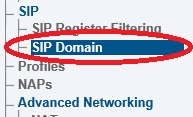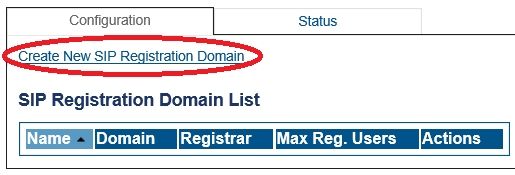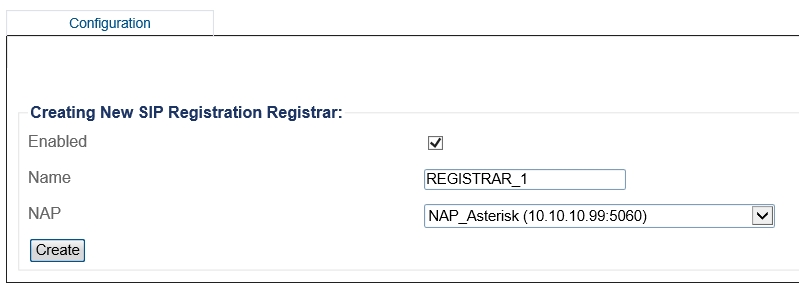Creating a SIP Domain
A "SIP Domain" represents a domain name to which users can register. It also defines registrars from which the SBC forwards registration requests.
The creation of SIP domains is performed as follows:
1. Select SIP Domain in the navigation panel

2. Click Create New SIP Regisration Domain

3. Configure the SIP Registration Domain

Enter a configuration Name for this domain.
Enter a Domain Name for the SIP Registration Domain. A domain can be a FQDN or an IP address.
Set the number Maximum Registered Users for this domain
Set the Expires value used by SBC when the remote device doesn't supply one (Default Contact Expiration)
Select Routing Method the system will use to route calls to registered users (if enabled in routing scripts).
Register source: Sends SIP Invite to the registering source IP address.
Contact: Sends SIP Invite to the 'contact' from the Register message.
Set the Default Contact Expiration, this value will be used when no Expires value is supplied by the user agent.
Set the Minimum Contact Expiration, this is the minimum Expires value that can be supplied by a user agent. Lower values will be rejected with a 423 'Interval too brief' response.
Set the Maximum Contact Expiration, this is the maximum Expires value that can be supplied by a user agent. Higher value are replaced by this parameter.
Forwarding Parameters:
Select the Registration Forwarding Mode to the registrar:
Contact Remapping: Changes the user and the IP address.
Contact Passthrough: Doesn't change anything. Enables devices to be contacted directly without going through the SBC.
Set Minimum Registrar Expiration, this is the minimum Expires value sent by the SBC to the registrar. If a user agent 'Expires' value is greater than this parameter, the SBC will do rate adaptation between the user agent and the Registrar.
Set Maximum Pending Register Forward, the maximum number of simultaneous pending register requests allowed for this domain. New REGISTER requests are being refused passed this threshold.
Set Maximum Simultaneous Register Forward, the maximum number of simultaneous active register requests allowed for this domain. New REGISTER requests are being refused passed this threshold.
Select the Registration Registrar Selection Mode to the registrar:
Active/Standby: The active registrar is the one with status up and the lowest priority (automatic fallback).
Enable the Forward After Switchover: After a switchover, the first register refresh request from each user will be forwarded to the active registrar.
Click Create
4. Verify that the Sip registration domain was successfully created message appears

4.a. You can create and update the SIP Registration Domain with RESTful API. Please check the following link:
5. Create one or multiple SIP registrars for the SIP domain
Click the SIP domain that was just created
Click Create New SIP Registration Registrar

6. Enter the name of SIP Registration Registrar
Select a NAP
Click Create

6.a. You can create and update SIP Registration Registrar with RESTful API. Please refer to the following link:
Multiple registrars (registration redundancy) Multiple registrars can be created per domain, for redundancy.
Registrars are ordered by priority
Users' registration requests are forwarded to the available registrar with the highest priority in the list
SIP 'options' polling is used to determine which registrars are available or not

Create routes for registered users
In most cases, FreeSBC will route SIP calls (SIP Invite) to registered users. This is done by creating appropriate routes.
Last updated
Was this helpful?
